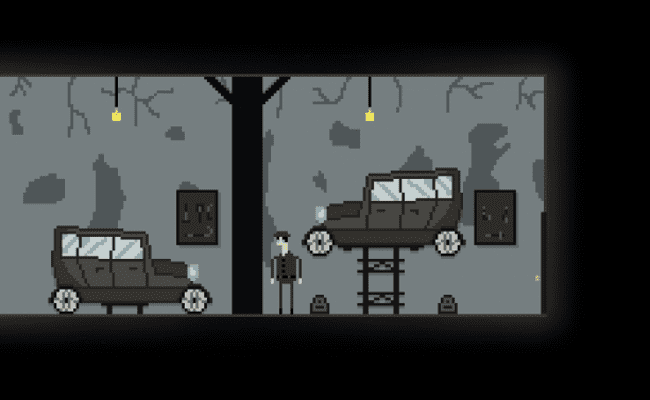
Noir Syndrome is an indie game produced by Glass Knuckle Games. It presents the player with the role of playing a private eye in a procedurally-generated murder mystery that changes every time you play. Like film noir itself, the game draws its stories from the pulpy, hard-boiled detective fiction of the early 20th century. Each game begins with a murder and places the detective in a run down apartment. Every case allows the player 14 days to solve the mystery, after which they either solve the case, the detective dies, or is fired.
Noir Syndrome take place in a pixelated prohibition-era American city. The city map is complete with notable noir settings, such as a speakeasy, high class hotels, warehouses, and slums. The setting, like most film noir, is an urban sprawl. While the map is constant, clues, suspects, and resources will be randomly distributed throughout each playthrough. This randomization may create heavily unbalanced or overly easy scenarios to solve. There are no guarantees.
The game is heavily color coded. When a murder is committed, the crime scene will be coded brown. While green, red, and blue correspond to suspects from different echelons of society, civilian, mob, or police accordingly. Sprites will also dress in their corresponding colors. After you start collecting clues, buildings on the map will become color coded with a node above them, indicating whether civilians, mobsters, or police are present. When an npc tells you a location sounds fishy that location will appear in purple. And if you are ready to accuse a suspect, a black node will appear above the last position that they were spotted.
Gameplay is further delineated by hobbies and sex. Every suspect will belong to an affiliation, have a hobby, and be one sex. Uncovering clues will usually present a binary set of options. Finding a pencil will suggest that the culprit is either an artist or a poet. While finding an iron button will identify either a civilian or a mobster. Occasionally, there will be a definitive clue such as finding police identification or female finger prints, though these are rare. Some clues, though, are useless, such as paperwork that could essentially belong to anyone. In the end, there will be ten sets of suspects and ten different clues of varying helpfulness.
The procedural-generation allows for seemingly endless scenarios. Though, this is also one of its drawbacks. Because each game must be different, the clues, hobbies and combinations thereof run the gamut of being overly simplistic to downright nonsensical. How can a pencil be used by an artist or a poet but not a tailor? Who would leave paperwork at a crime scene? I know a game must have rules, and there has to be categorical boundaries but presenting clues within a false dichotomy of absolutes has an overly generic feel to it and draws attention to its limitations.
But Noir Syndrome isn’t a game about logic puzzles. It’s a game about the simplest form of logic: the process of elimination. Another result of randomization is that there cannot be a motive to the murder. They simply happen. They truly are random acts of violence. Still, Noir Syndrome isn’t a game that is attempting a serious tone. It is slightly absurd in form and style.
The pixel art style adds an abstract interface to the gameplay. It isn’t exactly what one would expect for artwork representing a classic noir setting, but it works well for the aesthetic of the game. The minimalist art style imprints a bare bones visual representation. Anything extraneous is left out. The pixel art also adds to the disorienting ambiance of noir in general. In noir, nothing is presented too clearly. Anything that can be seen can be clicked on, but doing so may prove fruitless, and the more the player clicks, the more energy the character expends. The detective can starve to death, so he must be fed regularly.
However, it’s the jazzy soundtrack that really sets the mood for Noir Syndrome. Almost every room features a different piece of music to reflect that particular setting. The music more so than the graphics reflects the time period represented in the game and creates an aura of realism that borders on parody, while still complimenting the overall style of the game.
Noir Syndrome is surprisingly open ended within its confines. The detective is given a gun, though shooting isn’t necessary. The player can choose to rob from safes or play bad cop and start shooting people indiscriminately. These actions will have consequences though. If you steal from a faction such as the mob, they will hunt you down and will fire on sight. It only takes one bullet to kill, and if you kill the suspect, you will automatically lose. The fourteen turn time limit almost encourages a fatalistic drive to go rogue and adds another nod to the noir conventions that it draws its influence from.
Noir Syndrome is simplistic enough to pick up and play and clever enough to keep you coming back for more. It is best played in short spurts and smartly self-imposes its own time limit by creating that fourteen turn game each round.


![Call for Papers: All Things Reconsidered [MUSIC] May-August 2024](https://www.popmatters.com/wp-content/uploads/2024/04/all-things-reconsidered-call-music-may-2024-720x380.jpg)



